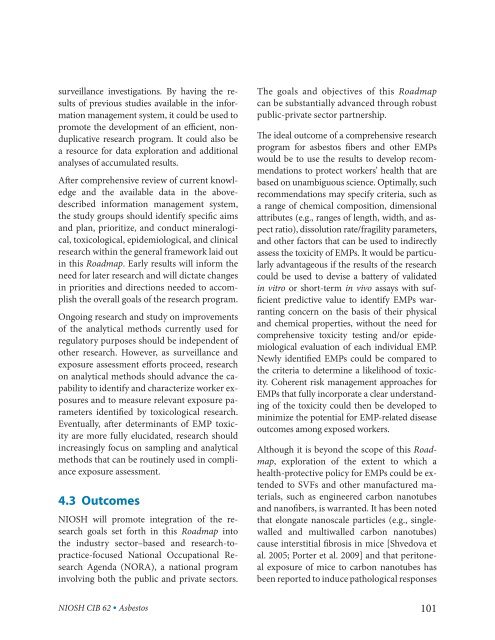Asbestos Fibers and Other Elongate Mineral Particles: State of the ...
Asbestos Fibers and Other Elongate Mineral Particles: State of the ...
Asbestos Fibers and Other Elongate Mineral Particles: State of the ...
- No tags were found...
You also want an ePaper? Increase the reach of your titles
YUMPU automatically turns print PDFs into web optimized ePapers that Google loves.
surveillance investigations. By having <strong>the</strong> results<br />
<strong>of</strong> previous studies available in <strong>the</strong> information<br />
management system, it could be used to<br />
promote <strong>the</strong> development <strong>of</strong> an efficient, nonduplicative<br />
research program. It could also be<br />
a resource for data exploration <strong>and</strong> additional<br />
analyses <strong>of</strong> accumulated results.<br />
After comprehensive review <strong>of</strong> current knowledge<br />
<strong>and</strong> <strong>the</strong> available data in <strong>the</strong> above-<br />
described information management system,<br />
<strong>the</strong> study groups should identify specific aims<br />
<strong>and</strong> plan, prioritize, <strong>and</strong> conduct mineralogical,<br />
toxicological, epidemiological, <strong>and</strong> clinical<br />
research within <strong>the</strong> general framework laid out<br />
in this Roadmap. Early results will inform <strong>the</strong><br />
need for later research <strong>and</strong> will dictate changes<br />
in priorities <strong>and</strong> directions needed to accomplish<br />
<strong>the</strong> overall goals <strong>of</strong> <strong>the</strong> research program.<br />
Ongoing research <strong>and</strong> study on improvements<br />
<strong>of</strong> <strong>the</strong> analytical methods currently used for<br />
regulatory purposes should be independent <strong>of</strong><br />
o<strong>the</strong>r research. However, as surveillance <strong>and</strong><br />
exposure assessment efforts proceed, research<br />
on analytical methods should advance <strong>the</strong> capability<br />
to identify <strong>and</strong> characterize worker exposures<br />
<strong>and</strong> to measure relevant exposure parameters<br />
identified by toxicological research.<br />
Eventually, after determinants <strong>of</strong> EMP toxicity<br />
are more fully elucidated, research should<br />
increasingly focus on sampling <strong>and</strong> analytical<br />
methods that can be routinely used in compliance<br />
exposure assessment.<br />
4.3 Outcomes<br />
NIOSH will promote integration <strong>of</strong> <strong>the</strong> research<br />
goals set forth in this Roadmap into<br />
<strong>the</strong> industry sector–based <strong>and</strong> research-to-<br />
practice-focused National Occupational Research<br />
Agenda (NORA), a national program<br />
involving both <strong>the</strong> public <strong>and</strong> private sectors.<br />
NIOSH CIB 62 • <strong>Asbestos</strong><br />
The goals <strong>and</strong> objectives <strong>of</strong> this Roadmap<br />
can be substantially advanced through robust<br />
public-private sector partnership.<br />
The ideal outcome <strong>of</strong> a comprehensive research<br />
program for asbestos fibers <strong>and</strong> o<strong>the</strong>r EMPs<br />
would be to use <strong>the</strong> results to develop recommendations<br />
to protect workers’ health that are<br />
based on unambiguous science. Optimally, such<br />
recommendations may specify criteria, such as<br />
a range <strong>of</strong> chemical composition, dimensional<br />
attributes (e.g., ranges <strong>of</strong> length, width, <strong>and</strong> aspect<br />
ratio), dissolution rate/fragility parameters,<br />
<strong>and</strong> o<strong>the</strong>r factors that can be used to indirectly<br />
assess <strong>the</strong> toxicity <strong>of</strong> EMPs. It would be particularly<br />
advantageous if <strong>the</strong> results <strong>of</strong> <strong>the</strong> research<br />
could be used to devise a battery <strong>of</strong> validated<br />
in vitro or short-term in vivo assays with sufficient<br />
predictive value to identify EMPs warranting<br />
concern on <strong>the</strong> basis <strong>of</strong> <strong>the</strong>ir physical<br />
<strong>and</strong> chemical properties, without <strong>the</strong> need for<br />
comprehensive toxicity testing <strong>and</strong>/or epidemiological<br />
evaluation <strong>of</strong> each individual EMP.<br />
Newly identified EMPs could be compared to<br />
<strong>the</strong> criteria to determine a likelihood <strong>of</strong> toxicity.<br />
Coherent risk management approaches for<br />
EMPs that fully incorporate a clear underst<strong>and</strong>ing<br />
<strong>of</strong> <strong>the</strong> toxicity could <strong>the</strong>n be developed to<br />
minimize <strong>the</strong> potential for EMP-related disease<br />
outcomes among exposed workers.<br />
Although it is beyond <strong>the</strong> scope <strong>of</strong> this Roadmap,<br />
exploration <strong>of</strong> <strong>the</strong> extent to which a<br />
health-protective policy for EMPs could be extended<br />
to SVFs <strong>and</strong> o<strong>the</strong>r manufactured materials,<br />
such as engineered carbon nanotubes<br />
<strong>and</strong> nan<strong>of</strong>ibers, is warranted. It has been noted<br />
that elongate nanoscale particles (e.g., singlewalled<br />
<strong>and</strong> multiwalled carbon nanotubes)<br />
cause interstitial fibrosis in mice [Shvedova et<br />
al. 2005; Porter et al. 2009] <strong>and</strong> that peritoneal<br />
exposure <strong>of</strong> mice to carbon nanotubes has<br />
been reported to induce pathological responses<br />
101

















